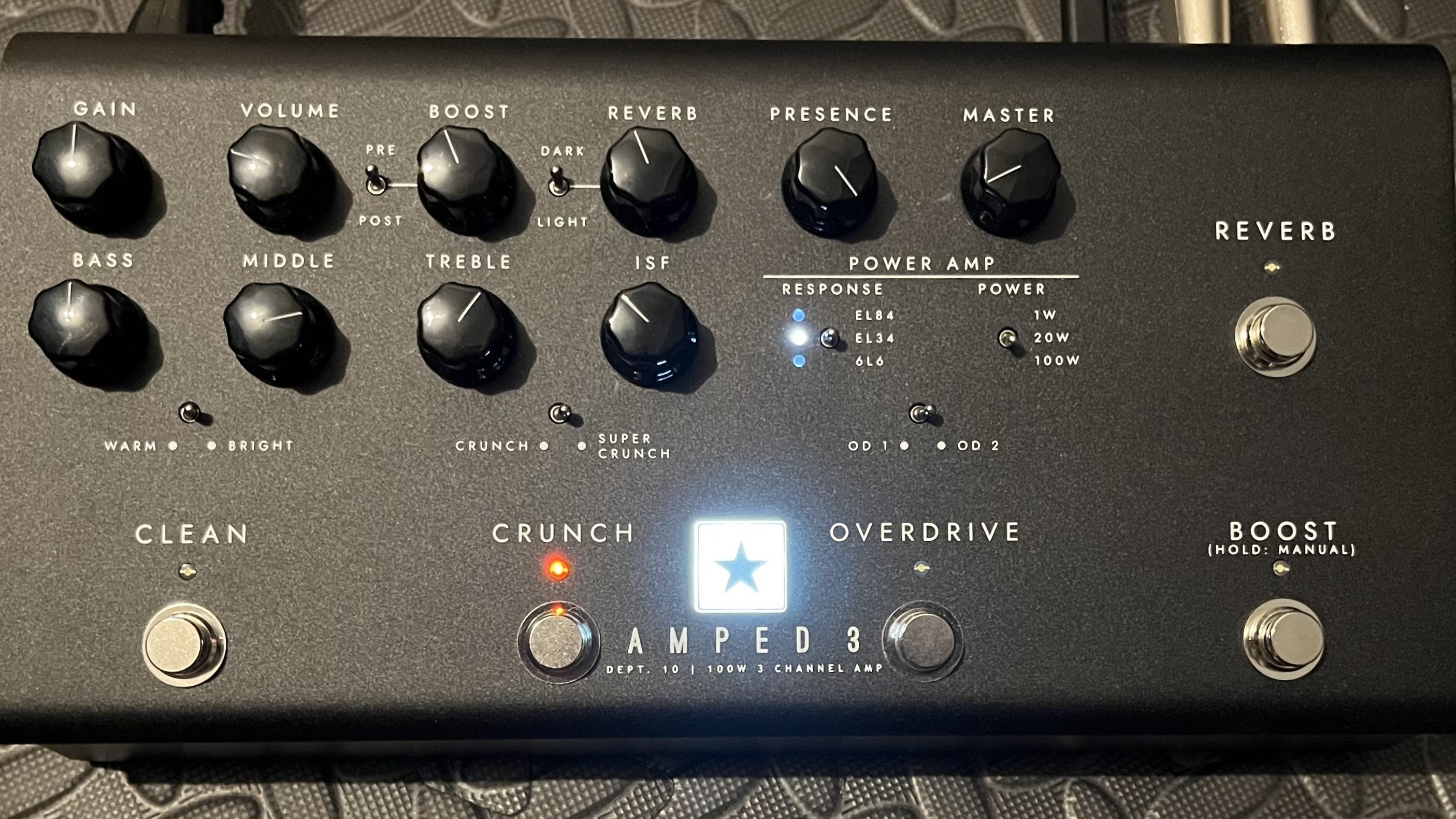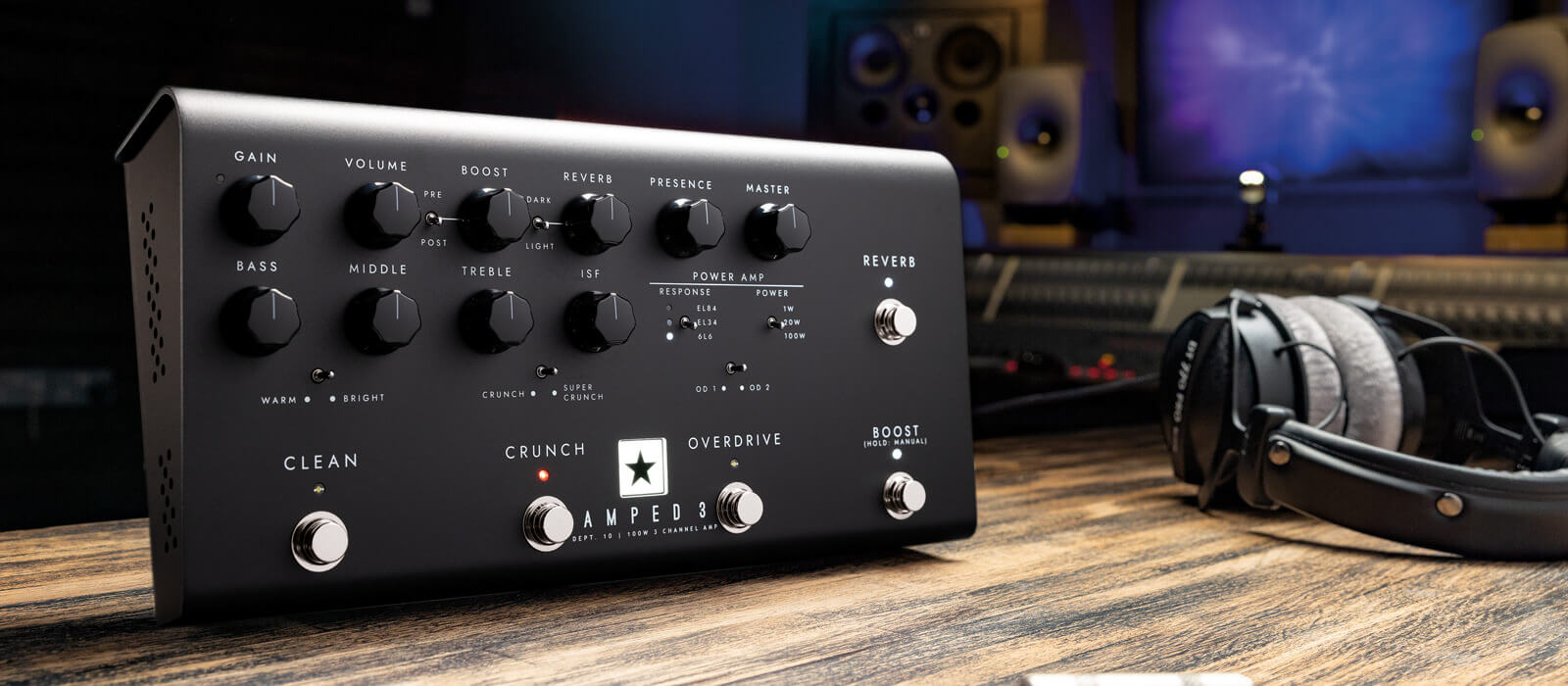MusicRadar Verdict
Ditching your amp is a giant leap, but if you’re limbering up, the Amped 3 is a great safety net and all-around option.
Pros
- +
Lightweight.
- +
Loads of features.
- +
Excellent sounds.
- +
Exhaustive connectivity options.
Cons
- -
It loses the effects of the Amped 2.
MusicRadar's got your back
Blackstar Dept. 10 Amped 3: What is it?
You might have noticed, guitar amps are evolving. Making our guitars audible was once limited to one or two heavy boxes, but in recent years the options have widened out considerably. From lightweight, modelling and profiling, the last 18 months have seen many amp manufacturers do away with a traditional amp head-and-cab or combo solution and turn their attention floorwards.
That’s exactly what Blackstar has done with the Amped 3, which continues the brand’s Dept. 10 series of pedal-based amp solutions. But how can a pedal be an amp?
The answer is more straightforward than you might think. The Amped 3 combines a multi-channel front end with a 100-watt, Class D digital power amp, Blackstar’s CabRig technology and flexible connectivity to pack everything you’d expect — and possibly even more — from a traditional amp head into a lightweight, floor-based solution. From here you can choose whether you send your signal into a passive speaker cab, or go direct via the cabinet simulation into an FRFR active cabinet, PA system, monitor speaker or recording device.
Of course, that’s just the concept and it’s applicable to the entire Amped line-up. But the basic idea is if you’re playing rig-share gigs where bringing your own cab is redundant, travelling to gigs where space and weight are limited, or simply moving with the times and going for a more modern-style setup, the Amped 1, 2 or 3 will have you covered.
As mentioned, this is the third iteration of the Amped concept, with the 1 and 2 launching earlier in 2023, so you could well be wondering, ‘Why are there three of them?’. Well, it’s a question of application. Amped 1 is a smaller, simpler affair with pedal/modelling users in mind, while the Amped 2 adds modulation, delay and reverb effects, an onboard tuner and greater hands-on control for a more ‘complete’ rig centrepiece.
Amped 3 uses the same housing outline as Amped 2, but here, the delay and modulation effects are stripped out, as is the tuner, and they’re replaced with a three-channel design with a switchable pre/post preamp boost circuit. We get a single set of controls for gain, volume three-band EQ, Blackstar’s ISF control, plus voicing switches for each channel (Warm/Bright for clean, Crunch and Super Crunch for the Crunch channel and OD1/OD2 for the overdrive channel). There’s a level knob for the boost, which offers up to 12dB, and another toggle switch changes the placement in your chain from pre (more gain) to post (more volume).
Moving to the power amp controls, there’s a presence control and master volume, but Blackstar has also equipped the Amped 3 with its Power Amp Response and Power switches. Response shifts the feel and tonality of the amp to correspond with popular output valves; there’s a choice of EL84, EL34 and 6L6, and the Power toggle reduces the wattage in three steps with 100/20/1-watt modes.
Want all the hottest music and gear news, reviews, deals, features and more, direct to your inbox? Sign up here.
It still has reverb, but the panel controls are reduced to a simple level and toggle switch to choose between dark/light reverb tone, and further editing to the reverb’s parameters can be edited with Blackstar’s Architect software. Incredibly, that’s not everything, as a quick look around the back reveals a three-position toggle switch to choose CabRig simulations.

Blackstar Dept. 10 Amped 3: Performance and verdict
Now, the Amped 3 can operate in one of two modes at any one time: Patch or Manual. Amped 3 defaults to patch mode straight out of the box, and you can switch between the two by holding down the Boost footswitch.
Patch mode, as you might expect, allows you to recall a previously saved setup for each channel, and within your patch you can save the settings for nearly every parameter (power amp Power is not included, nor is Reverb switching). So, if you want your clean channel to be super-high headroom with a US slant to it, you can set your gain and volume, adjust the EQ, position the ISF control to the left and choose 6L6s. Save it, move to the Crunch channel and you can have a chimey, EL84-powered amp on the edge of breaking up, and so on.
These are then recalled by simply selecting the channel you want. In doing so, the current state of the physical controls is then out of sync with the memorised settings, but Blackstar has included an indicator LED which lights up when you sweep through a control’s actual position, allowing you to see more clearly what the settings are.
In Manual mode, it’s WYSIWYG, and with only one set of controls shared between the channels, we think this mode will work better for set-and-forget players who are using modellers or external pedals and only require one ‘always on’ channel to act as a consistent amp. That said, engaging the boost in post mode will give you a pseudo-second volume control, even if the EQ etc. remains unchanged.
That’s a lot of spec to take in so far, but we’d suggest starting in patch mode if you’re looking to radically change between sounds easily.

In use, Amped 3 makes a lot of sense, just like your regular amp. Connecting to our computer, we not only get access to the Architect software you’ll need to download it first), but it also unlocks the Amped 3’s audio interface. This is where the real benefit of hands-on controls shows its face. If the best gear makes you want to play more while also inspiring creativity, then Blackstar has already won. Unlike some menu-based amp modellers and modelling-equipped multi-fx units, it’s incredibly quick to get a sound.
With our DAW loaded up and instantly recognising the Amped 3 as our interface, we’re able to start recording parts extremely quickly. But the benefit here is that with physical control, switching sounds for double-tracking or new parts is a doddle. It comes with the bonus of being able to simultaneously refine options such as the speaker cab, speaker type, mic type and more within the graphic environment of the Architect software, while also serving as an audio interface. Instead of getting lost in button presses and menus, we’re quickly on our fifth guitar part, each with its own tonal shift which has been shaped with controls rather than buttons. That can only be applauded, even if there’s no guarantee that the musical ideas are good!
It’s easy to overlook the fact with all of the current trends in floor-based solutions, that no matter which way you slice it, there’s still going to be an amplifier stage somewhere in your rig unless you’re going direct to a PA. That scenario would mean that you’re either hearing your guitar via monitor speakers, in-ears or the front-of-house rather than a dedicated speaker cab and if that’s the case then you might never connect a jack to the Amped’s speaker output.
That’s fine, as you can get all the other features through the passive outputs. But if you do want to run into a cab in 2023, the Amped 3’S lightweight, Class D digital power amp can drive any 8 or 16 Ohm cabinet with 100 watts (switchable down to 20 watts or 1-watt). At the highest setting, it makes for a great ‘transparent’ platform to output your sounds: plenty of headroom and power. Drop it down, though, and it starts to become more coloured, with additional amp-like compression creeping in. At 20 watts, it’ll still perform with enough power for a band situation, and the one-watt mode is great if you want to record via a cab at home without letting the volume levels get out of control. That said, we think this is most likely to be bypassed in favour of the CabRig options for recording situations.

Ok, so by design the Amped 3 doesn’t have the FX colour of the Amped 2, but when it comes to core tone creation it’s covering a lot of ground. The clean channel is capable of crystal clean and warm grit, the crunch channel has you covered for everything from organic blues to classic rock, and there’s a whole heap of gain available on the Overdrive channel. This brings us to one of our biggest revelations with the Amped 3. With claims of gain and ominous styling, this is clearly aimed at the hairier end of Blackstar’s demographic. But we say forget that.
Yes, it will do heavy tones with plenty of juice left in the tank, but it’s almost a disservice to look at this as ‘the metal one’. It’s arguably the most flexible in the range, especially if you want channel options, but already own a board full of carefully chosen pedals (which, by the way, it can send power to courtesy of a pair of 9v outputs). After all, just because it has some additional gain on tap, doesn’t mean you have to use it.
Conversely, if you are a heavier player and want a well-stocked, floor-based cornerstone to your amp-less rig, this is going to be high on your list of candidates. Elsewhere, the Amped 3 is full of response, the Crunch and Overdrive channels react to our guitar volume control changes dynamically and the sheer number of sounds to hand is impressive.
With so many brands vying for our money in this area of the market, the Amped 3 has a lot to offer. It’s a complete all-around solution, will work wherever you can plug it in with no need to adapt your voltage, can play nicely with your pedals and is small and light enough to remove some logistical considerations too.
MusicRadar verdict: Ditching your amp is a giant leap, but if you’re limbering up, the Amped 3 is a great safety net and all-around option.
Blackstar Dept. 10 Amped 3: The web says
"Despite the absence of the onboard effects, the sheer quality and versatility of tones makes this the finest Amped model yet."
Guitar
Blackstar Dept. 10 Amped 3: Hands-on videos
Noisegate
Andertons
PMT
Blackstar Dept. 10 Amped 3: Specifications
- Type: Pedal-based amp solution
- Channels: Clean, Crunch, Overdrive (with boost circuit applicable on all three)
- Controls: Gain, volume, bass, middle, treble, ISF, boost (pre/post switchable), reverb level, presence, master volume, 3x voice switches (one per-channel), power amp Valve Response, output power switch (Watts), CabRig preset switch
- Footswitches: Clean, crunch, overdrive, boost, reverb
- Output: 100 watts (switchable to 20 or one watt)
- Dimensions: 288mm x 149mm x 81mm [WxDxH]
- Sockets: Input, output, line output/headphones, XLR output, speaker outputs (8 or 16 Ohm), USB C (four-channel audio interface) FX send/return, 9v outputs x2 (max 500 mA)
- FX Loop: Series/parallel
- Effects: Reverb
- Power: IEC mains cable
- Contact: Blackstar Amplification

Stuart has been working for guitar publications since 2008, beginning his career as Reviews Editor for Total Guitar before becoming Editor for six years. During this time, he and the team brought the magazine into the modern age with digital editions, a Youtube channel and the Apple chart-bothering Total Guitar Podcast. Stuart has also served as a freelance writer for Guitar World, Guitarist and MusicRadar reviewing hundreds of products spanning everything from acoustic guitars to valve amps, modelers and plugins. When not spouting his opinions on the best new gear, Stuart has been reminded on many occasions that the 'never meet your heroes' rule is entirely wrong, clocking-up interviews with the likes of Eddie Van Halen, Foo Fighters, Green Day and many, many more.
